What To Think About When Thinking About a New Kitchen
what to think about when thinking about a new kitcheN
Kitchen pre-thinking
Kitchens are a mainstay of CMID’s work and are nearly always an integral part of any home. Designing kitchens can be complex for the process has many working and moving parts. It’s work that requires early consideration and forethought on the part of the client. With this in mind, here are some insights into what to think about before engaging an interior designer on a new kitchen.
IDEALISE + ARTICULATE
To begin, it is good to idealise what you want your kitchen to be and then be able to articulate this to your designer. This can be done in broad strokes initially to allow your designer an understanding of how the kitchen is intended to look and function.
Providing some early details can be useful, however. This may include preferred appliances and the style of the kitchen. Equally useful for planning purposes is letting the designer know of any ‘unusual’ objects to be housed in the kitchen, such as larger platters.
It is important to note that ideas can, of course, evolve during the course of the design process. But, talking to your designer about these ideas early on can provide much-needed direction to get the work started.
CMID Newtown House Project.
CMID Herd Street Office Project.
Having visual demonstrations of appealing kitchens is a good idea too. Pinterest and Instagram are your friends in this regard. Design inspiration aside, this also allows the designer to locate the client on the design spectrum — classic, modernist, minimalist, contemporary, etc — to help inform decision-making.
Supplying the designer with relevant house plans at the start is also helpful, for various reasons. Not only does this help identify what is possible – and whether interior architecture should enter the chat (see another TID article on interior architecture) — it also may have a direct impact on budget. This is another key aspect of a client’s early thought process.
CMID Karori Kitchen #2 Project.
POCKETBOOK THoughts
A budget helps to frame the design process early on. It is important to be honest and direct with the designer about the investment allocated for the project. And when calculating the budget, remember appliances and other objects may produce budget creep. Bear in mind though that any designer worth their salt will always seek ways to work within the budget.
It’s not just setting a budget within one’s means that is important early on; also important is budgeting within one’s aspirations. It’s okay to think ambitiously in terms of scale and look. But it’s even better to think practically and realistically by having a budget that accurately reflects your design goals.
This also means being practical around available space. Is there sufficient space to meet your design goals (and budget)? Your original house plans will help the designer determine this.
CMID Brooklyn House Project.
EXPECTATIONS
The designer is equipped to help manage your expectations throughout the design process. It is good that these expectations are established early in the process. This includes budgets, space, and, importantly time on the understanding there will be a period of change (and possible inconvenience) during the construction phase of the project.
Be prepared that good design work can take time (but not excessively so) and the building schedule can be affected by available materials and labour i.e. factors outside the interior designer’s control.
This short guide simply aims to trigger some thinking to help best utilise your relationship with your designer and make the most of your initial engagement to make the process more effective and efficient for both client and designer.
CMID Karori House Project.
Words by: Craig Greaves.






